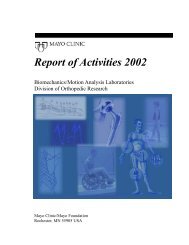Finding Optimal Cutpoints for Continuous ... - Research - Mayo Clinic
Finding Optimal Cutpoints for Continuous ... - Research - Mayo Clinic
Finding Optimal Cutpoints for Continuous ... - Research - Mayo Clinic
You also want an ePaper? Increase the reach of your titles
YUMPU automatically turns print PDFs into web optimized ePapers that Google loves.
general. In situations when the estimated cutpoint is close to boundaries, one should carefully<br />
examine the reasons as the cutpoint obtained may be real or may be due to the presence of<br />
outliers.<br />
5. Discussion<br />
Given the widespread use of categorizing a continuous covariate, there is very little<br />
attention given to this topic in statistical and epidemiological textbooks and in the literature. We<br />
have only focused on the dichotomization of a continuous covariate with the assumption that<br />
such a dichotomization is possible from biological point of view, however, in reality, more than<br />
one cutpoint may exist. Our current work provides an insight into some of the outcome-oriented<br />
cutpoint determination methods as well as SAS ® macros that provide p-values adjusted <strong>for</strong><br />
examining multiple candidate cutpoints.<br />
Ideally this cutpoint search has to be done within the framework of a multiple regression<br />
model to eliminate the potential influence of other prognostic factors on the cutpoint. As stated<br />
be<strong>for</strong>e, one has to be also aware of potential confounding that might arise from categorization<br />
and using open-ended categories [32]. The obtained cutpoint(s) may differ across studies<br />
depending on several factors including which data or outcome-oriented approach is used and<br />
there<strong>for</strong>e the results may not be comparable. Lastly, there is always the possibility of loss in<br />
in<strong>for</strong>mation from categorizing a continuous covariate, possible loss of power to detect actual<br />
significance and can sometimes lead to biased estimates in regression settings, all of which need<br />
to be sufficiently addressed [33, 34].<br />
19




